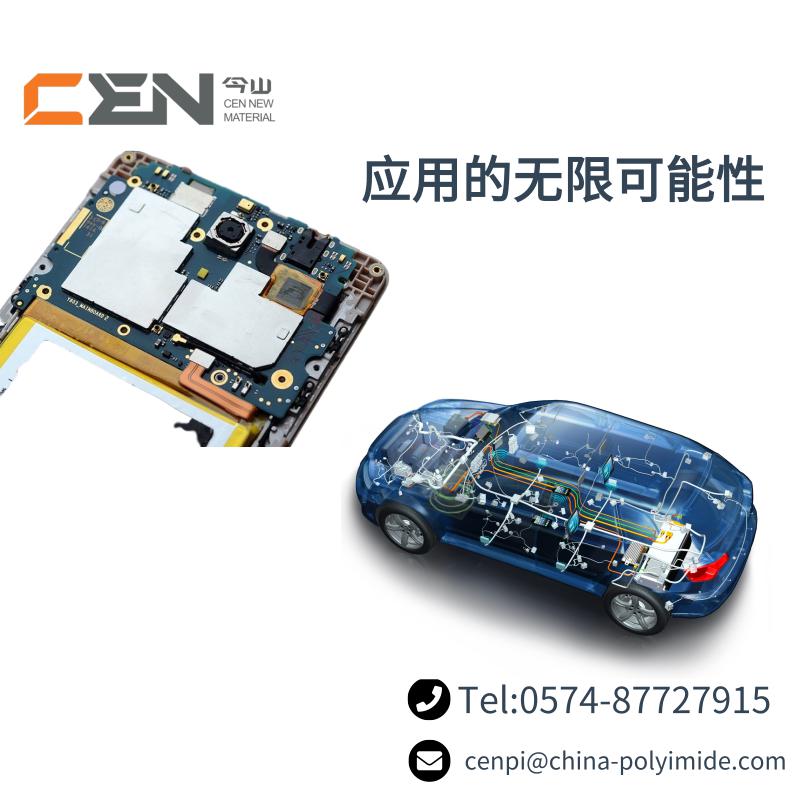The production of polyimide film is basically a two-step process, the first step is the synthesis of polyamide acid, the second step is the film imidization.
1. Salivation
In the early stage, the polyimide film developed by DuPont company was homobenzene type. This kind of film is polycondensated by pyromellitic dianhydride (PMDA) and aromatic diamines in polar solvent to produce intermediate polyamide acid, which is then converted from polyamide acid to polyimide through tape casting, solvent removal, dehydration and closed-loop (imidization).
The process of producing PI film by salivation method is as follows: evenly flow the polyamide acid (PAA) solution onto a continuously running metal belt, and pass through a drying oven with the movement of the metal belt to evaporate part of the solvent. The partially dried PAA film can be peeled off from the metal belt, dried by heating roller, and then quenched and rolled up to obtain continuous length Degree of film. Such a process is called salivation. In the salivation molding process, due to the evaporation of solvent and the high price of solvent, it is necessary to increase the solvent recovery system to reduce the cost.
The main equipment, preparation steps and product detection of PI film produced by salivation method are as follows.
(1) Main equipment: stainless steel resin solution storage tank, salivating mouth, salivating machine, imidizing furnace, winding machine and hot air system.
(2) Preparation steps:
After defoaming, the polyamide acid (PAA) solution is pressed by the stainless steel solution storage tank through the pipeline into the salivating mouth storage tank on the front machine head. The steel strip runs at a uniform speed in the direction shown in the figure. The solution in the storage tank is taken away by the scraper in front of the salivating mouth to form a liquid film with uniform thickness, and then enters the drying channel for drying.
The clean and dry air is sent to the heater by the blower and preheated to a certain temperature before entering the upper and lower drying channels. The hot air flow direction is opposite to the running direction of the steel strip, so that the temperature of the liquid film is gradually increased and the solvent is gradually volatilized to increase the drying effect.
When the polyamide acid film runs on the steel strip for one week, the solvent evaporates into a solid film, and the film peeled from the steel strip is led to the imidizing furnace through the guide roller.
The imidizing furnace is generally in the form of multi rollers. The guide roller with synchronous speed with the salivating machine guides the polyamide acid film into the imidizing furnace. After high temperature imidization, the polyimide film can still show excellent physical, mechanical and electrical properties from cryogenic-269 ℃ to high temperature + 400 ℃.
(3) Product testing
After the products are manufactured, the tensile strength, elongation at break, power frequency electrical strength, surface resistivity and volume resistivity should be tested.
The results show that the length of PI film is not limited, the stripping is convenient, the flatness is good and the thickness is uniform. However, the precision of the equipment is high, and the viscosity of PAA solution is large, so it is difficult to defoamer and filter, and the production speed is slow. Therefore, salivation is mainly used for plastics with high melting temperature and high melt viscosity, which are not suitable for extrusion or calendering, or for plastics whose decomposition temperature is close to the melting temperature.
2. Salivation biaxial stretching method
Under heating conditions, the film is stretched along one (uniaxial) or two (biaxial) directions in plane coordinates, so that the macromolecular chains are stretched along the stretching direction to change some properties of the film. This process is called the stretching orientation of plastic film. In general, stretching is used to improve the mechanical properties of thermoplastic materials. There are uniaxial and biaxial (biaxial) stretching methods for preparing plastic film.
Uniaxial tensile equipment is relatively simple, however, although it enhances the mechanical properties of materials in the tensile direction, it also makes the mechanical properties of materials even worse in the vertical direction. Therefore, people are increasingly interested in biaxial stretching. Biaxial (biaxial ) stretching can make the molecular chain along the plane orientation, so that the material has good plane properties. Biaxial (biaxial) can be divided into secondary stretching and primary stretching. The so-called secondary stretching is to use a group of rollers with different drilling speeds to stretch parallel to the axial direction to a certain multiple (longitudinal stretching), and then use the gradually expanding opening angle on the fixture guide rail to stretch a certain number of times perpendicular to the axial direction (transverse stretching).
Biaxially stretching method is to add a stretching directional device after salivation method. The membrane is heated to a specified temperature and stretched to a large extent to make the molecular chains orderly arranged along the stretching direction. One direction is unidirectional, and the other is biaxial stretching. The tensile strength is 3-5 times better, the heat resistance and cold resistance are improved, and the physical properties are significantly improved. This method is used for high quality membranes. The PI films produced by biaxial orientation method are used in FCC l with high requirements in performance (size stability, etc.).
The stretching methods used in PI films are now subdivided into two categories: single stretching method and salivation stretching method. At present, the industry is more respected. To prepare PI film by salivation stretching method, the film formed by salivating PAA solution is evaporated to form a film. In the polyamide acid stage, the film is stretched directionally to make the molecular chain have a certain degree of regular arrangement. This is conducive to the balance of product performance, stability and consistency.
Biaxially oriented salivation stretching method includes resin synthesis, tape casting, biaxial orientation, winding and other processes.http://www.china-polyimide.com

